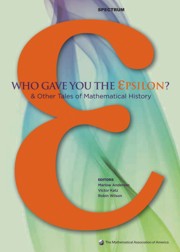Book contents
- Frontmatter
- Introduction
- Contents
- Analysis
- Geometry, Topology and Foundations
- Algebra and Number Theory
- Foreword
- Hamilton's Discovery of Quaternions
- Hamilton, Rodrigues, and the Quaternion Scandal
- Building an International Reputation: The Case of J. J. Sylvester (1814–1897)
- The Foundation Period in the History of Group Theory
- The Evolution of Group Theory: A Brief Survey
- The Search for Finite Simple Groups
- Genius and Biographers: The Fictionalization of Evariste Galois
- Hermann Grassmann and the Creation of Linear Algebra
- The Roots of Commutative Algebra in Algebraic Number Theory
- Eisenstein's Misunderstood Geometric Proof of the Quadratic Reciprocity Theorem
- Waring's Problem
- A History of the Prime Number Theorem
- A Hundred Years of Prime Numbers
- The Indian Mathematician Ramanujan
- Emmy Noether
- “ Marvelous Proof,”
- Afterword
- Surveys
- Index
- About the Editors
The Foundation Period in the History of Group Theory
from Algebra and Number Theory
- Frontmatter
- Introduction
- Contents
- Analysis
- Geometry, Topology and Foundations
- Algebra and Number Theory
- Foreword
- Hamilton's Discovery of Quaternions
- Hamilton, Rodrigues, and the Quaternion Scandal
- Building an International Reputation: The Case of J. J. Sylvester (1814–1897)
- The Foundation Period in the History of Group Theory
- The Evolution of Group Theory: A Brief Survey
- The Search for Finite Simple Groups
- Genius and Biographers: The Fictionalization of Evariste Galois
- Hermann Grassmann and the Creation of Linear Algebra
- The Roots of Commutative Algebra in Algebraic Number Theory
- Eisenstein's Misunderstood Geometric Proof of the Quadratic Reciprocity Theorem
- Waring's Problem
- A History of the Prime Number Theorem
- A Hundred Years of Prime Numbers
- The Indian Mathematician Ramanujan
- Emmy Noether
- “ Marvelous Proof,”
- Afterword
- Surveys
- Index
- About the Editors
Summary
Introduction
The earliest group notions
Henri Poincaré has pointed out that the fundamental conception of a group is evident in Euclid's work; in fact, that the foundation of Euclid's demonstrations is the group idea. Poincaré establishes this assertion by showing that such operations as successive superposition and rotation about a fixed axis presuppose the displacements of a group. However much the fundamental group notions were unconsciously used in the work of early mathematicians, it was not until the latter part of the eighteenth century that these notions began to take life and develop.
The foundation period
The period of foundation of group theory as a distinct science extends from Lagrange (1770) to Cauchy (1844–1846), a period of seventy-five years. We find Lagrange considering the number of values a rational function can assume when the variables are permuted in every possible way. With this beginning the development may be traced down through the contributions of Vandermonde, Ruffini, Abbati, Abel, Galois, Bertrand and Hermite, to Cauchy's period of active production (1844–1846). At the beginning of this period group theory was a discovery useful in the theory of equations; at the end it existed as a distinct science, not yet, to be sure, entirely free but so nearly so that this may be called the close of the foundation period.
Lagrange, Ruffini, Galois
Lagrange
The contributions of Lagrange are included in his memoir [7], published at Berlin in 1770–1771. In this paper Lagrange first applies what he calls the “calcul des combinaisons” to the solution of algebraic equations.
- Type
- Chapter
- Information
- Who Gave You the Epsilon?And Other Tales of Mathematical History, pp. 230 - 236Publisher: Mathematical Association of AmericaPrint publication year: 2009

